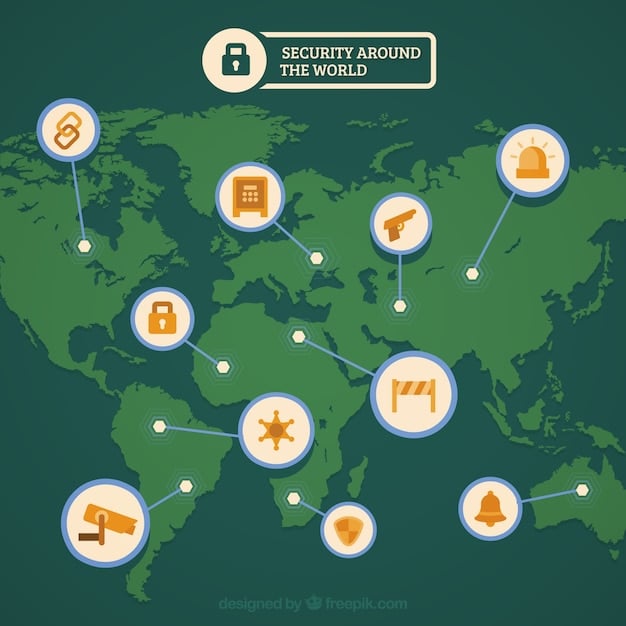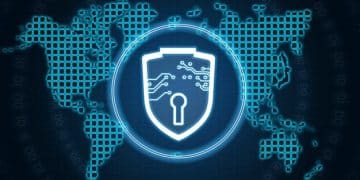US Cybersecurity Regulations: Business Protection in 2025

US Regulations on Cybersecurity in 2025 are crucial for businesses to protect against evolving cyber threats, encompassing compliance with federal laws, implementation of robust security measures, and proactive risk management strategies to safeguard data and maintain operational integrity.
Cybersecurity is a constantly evolving field, and as we move closer to 2025, understanding and adapting to the US Regulations on Cybersecurity: Protecting Your Business from Cyber Threats in 2025 becomes paramount. These regulations are designed to safeguard businesses from increasingly sophisticated cyberattacks, ensuring data protection and operational continuity.
Understanding the Current Cybersecurity Landscape
To effectively prepare for 2025, it’s essential to understand the current cybersecurity landscape in the US. This involves knowing the existing regulations, the prevalent threats, and the overall state of cybersecurity preparedness among businesses.
Key Existing Regulations
Several key regulations currently shape the cybersecurity landscape in the US. These regulations provide a framework for businesses to follow, ensuring a baseline level of cybersecurity protection.
- HIPAA (Health Insurance Portability and Accountability Act): Protects sensitive patient health information.
- GLBA (Gramm-Leach-Bliley Act): Requires financial institutions to protect consumers’ private financial information.
- CCPA (California Consumer Privacy Act): Grants California consumers various privacy rights, including the right to know, the right to delete, and the right to opt-out of the sale of their personal information.
- NIST Cybersecurity Framework: A voluntary framework that provides a set of standards, guidelines, and best practices to manage cybersecurity-related risks.

Prevalent Cyber Threats
The cybersecurity landscape is constantly under threat from various malicious actors. Understanding these threats is crucial for developing effective defense strategies.
Some of the most prevalent cyber threats include:
- Ransomware: Malware that encrypts a victim’s files, demanding a ransom to restore access.
- Phishing: Fraudulent attempts to obtain sensitive information such as usernames, passwords, and credit card details by disguising as a trustworthy entity.
- Malware: Software that is intentionally designed to cause damage to a computer, server, or computer network.
- DDoS (Distributed Denial of Service) Attacks: Overwhelming a server with traffic, making it unavailable to its intended users.
In conclusion, a clear understanding of the current cybersecurity regulations and threat landscape is essential for developing effective strategies to protect your business. Staying informed and proactive can significantly reduce the risk of cyberattacks and data breaches.
Anticipated Changes in US Cybersecurity Regulations by 2025
As technology evolves, so too do the regulations surrounding cybersecurity. By 2025, we can expect to see several key changes in US cybersecurity regulations, driven by emerging threats and technological advancements.
These changes will likely focus on:
Increased Focus on Data Privacy
Data privacy is already a significant concern, and this will only intensify by 2025. New regulations are expected to expand consumer rights and place greater obligations on businesses to protect personal data.
Several states are considering or have already implemented laws similar to the CCPA, and a federal privacy law could be on the horizon. This would create a more unified and comprehensive approach to data privacy across the US.
Enhanced Cybersecurity Standards
The NIST Cybersecurity Framework is likely to evolve, incorporating new best practices and addressing emerging threats. Compliance with this framework may become mandatory for certain industries or government contractors.
Additionally, we may see the implementation of sector-specific cybersecurity standards, tailored to the unique risks and challenges faced by different industries such as finance, healthcare, and critical infrastructure.
Stricter Enforcement and Penalties
Regulatory bodies are likely to increase their enforcement efforts, conducting more audits and investigations to ensure compliance with cybersecurity regulations. Penalties for non-compliance could become more severe, including hefty fines and reputational damage.

Companies must stay ahead of these changes by continuously monitoring the regulatory landscape and adapting their cybersecurity practices accordingly. Proactive compliance will be essential to avoid penalties and maintain a strong security posture.
In conclusion, anticipated changes in US cybersecurity regulations by 2025 highlight the need for businesses to prioritize data privacy, enhance their cybersecurity standards, and prepare for stricter enforcement. Staying informed and adaptable will be crucial for maintaining compliance and protecting against evolving cyber threats.
Preparing Your Business for Future Regulations
Preparing your business for future cybersecurity regulations requires a proactive and comprehensive approach. This involves assessing your current security posture, implementing necessary controls, and fostering a culture of cybersecurity awareness within your organization.
Conducting a Cybersecurity Risk Assessment
The first step in preparing for future regulations is to conduct a thorough cybersecurity risk assessment. This involves identifying your organization’s assets, evaluating the potential threats and vulnerabilities, and determining the likelihood and impact of a cyberattack.
A risk assessment should consider:
- Identifying critical assets and data.
- Evaluating potential threats (e.g., ransomware, phishing, malware).
- Assessing vulnerabilities in your systems and processes.
- Determining the likelihood and impact of a successful cyberattack.
Once you have identified your risks, you can prioritize them and develop a plan to mitigate them. This may involve implementing new security controls, updating existing ones, or improving your incident response capabilities.
Implementing Enhanced Security Controls
Based on your risk assessment, you should implement enhanced security controls to protect your organization’s assets and data. These controls may include:
- Strong Passwords and Multi-Factor Authentication: Implementing strong password policies and requiring multi-factor authentication can significantly reduce the risk of unauthorized access.
- Regular Software Updates and Patch Management: Keeping your software up to date with the latest security patches is essential to protect against known vulnerabilities.
- Firewalls and Intrusion Detection Systems: Implementing firewalls and intrusion detection systems can help prevent and detect malicious activity on your network.
- Data Encryption: Encrypting sensitive data both in transit and at rest can protect it from unauthorized access.
Fostering a Culture of Cybersecurity Awareness
Cybersecurity is not just a technical issue; it’s also a human one. Your employees are your first line of defense against cyber threats, so it’s essential to foster a culture of cybersecurity awareness within your organization.
This can be achieved through:
- Regular cybersecurity training for all employees.
- Phishing simulations to test employees’ awareness.
- Clear policies and procedures for reporting security incidents.
- Promoting a culture of vigilance and responsibility.
In conclusion, preparing your business for future cybersecurity regulations requires a proactive approach that includes conducting risk assessments, implementing enhanced security controls, and fostering a culture of cybersecurity awareness. By taking these steps, you can significantly reduce your risk of cyberattacks and ensure compliance with evolving regulations.
The Role of AI and Automation in Cybersecurity
Artificial intelligence (AI) and automation are playing an increasingly important role in cybersecurity. These technologies can help businesses detect and respond to cyber threats more quickly and effectively, while also reducing the burden on human security professionals.
AI-Powered Threat Detection
AI can analyze vast amounts of data to identify patterns and anomalies that may indicate a cyberattack. This can help businesses detect threats more quickly and accurately than traditional security tools.
AI-powered threat detection systems can:
- Analyze network traffic to identify suspicious activity.
- Monitor user behavior to detect insider threats.
- Identify and block malware and phishing attacks.
By automating threat detection, AI can free up human security professionals to focus on more complex tasks, such as incident response and threat hunting.
Automated Incident Response
Automation can also be used to automate incident response, enabling businesses to respond to cyberattacks more quickly and effectively. Automated incident response systems can:
- Isolate infected systems to prevent the spread of malware.
- Block malicious traffic to prevent data exfiltration.
- Restore systems from backups to minimize downtime.
By automating incident response, businesses can reduce the impact of cyberattacks and minimize downtime.
Challenges and Considerations
While AI and automation offer many benefits for cybersecurity, there are also challenges and considerations to keep in mind. These include:
- Bias: AI algorithms can be biased if they are trained on biased data.
- Explainability: It can be difficult to understand how AI algorithms make decisions, which can make it challenging to trust them.
- Cost: Implementing AI and automation solutions can be expensive.
Businesses should carefully evaluate the benefits and challenges of AI and automation before implementing these technologies in their cybersecurity programs.
In conclusion, AI and automation are transforming the cybersecurity landscape, enabling businesses to detect and respond to cyber threats more quickly and effectively. By embracing these technologies, businesses can enhance their security posture and better protect their assets and data.
Cybersecurity Insurance: A Critical Component
Cybersecurity insurance is becoming an increasingly critical component of a comprehensive cybersecurity strategy. It can help businesses mitigate the financial impact of a cyberattack, covering expenses such as data breach notification, legal fees, and business interruption losses.
Understanding Cybersecurity Insurance Policies
Cybersecurity insurance policies typically cover a range of expenses, including:
- Data Breach Notification: Costs associated with notifying affected customers, employees, and regulators.
- Legal Fees: Costs associated with defending against lawsuits and regulatory investigations.
- Business Interruption Losses: Lost revenue and expenses incurred due to a cyberattack that disrupts business operations.
- Ransomware Payments: Costs associated with paying a ransom to recover data encrypted by ransomware.
However, it’s important to carefully review the terms and conditions of your cybersecurity insurance policy to understand what is covered and what is not. Some policies may exclude coverage for certain types of cyberattacks or require businesses to meet specific security standards to be eligible for coverage.
Selecting the Right Policy
When selecting a cybersecurity insurance policy, consider the following factors:
- Coverage Limits: Ensure that the policy provides sufficient coverage limits to cover your potential losses.
- Deductible: Consider the deductible amount and how it will impact your out-of-pocket expenses.
- Exclusions: Carefully review the policy exclusions to understand what is not covered.
- Security Requirements: Understand the security requirements that you must meet to be eligible for coverage.
Integrating Insurance into Your Cybersecurity Strategy
Cybersecurity insurance should be integrated into your overall cybersecurity strategy. It should not be seen as a replacement for implementing strong security controls, but rather as a complement to them.
Businesses should:
- Conduct a risk assessment to determine their potential losses from a cyberattack.
- Implement appropriate security controls to reduce their risk.
- Purchase cybersecurity insurance to cover the remaining risk.
In conclusion, cybersecurity insurance is a critical component of a comprehensive cybersecurity strategy. By understanding the different types of policies available, selecting the right policy for your business, and integrating insurance into your overall strategy, you can mitigate the financial impact of a cyberattack.
Staying Updated and Compliant
Staying updated and compliant with US cybersecurity regulations is an ongoing process. It requires continuous monitoring of the regulatory landscape, ongoing training and awareness, and regular security audits and assessments.
Continuous Monitoring of Regulations
Cybersecurity regulations are constantly evolving, so it’s essential to continuously monitor the regulatory landscape for changes. This can be done by:
- Subscribing to regulatory alerts and newsletters.
- Attending industry conferences and webinars.
- Consulting with legal and cybersecurity experts.
By staying informed about changes in regulations, you can ensure that your organization remains compliant and avoids penalties.
Ongoing Training and Awareness
Cybersecurity training and awareness should be an ongoing process, not just a one-time event. Regular training can help employees stay up to date on the latest threats and best practices, and it can reinforce the importance of cybersecurity within your organization.
Training should cover topics such as:
- Phishing awareness.
- Password security.
- Data privacy.
- Incident reporting.
Regular Security Audits and Assessments
Regular security audits and assessments can help you identify vulnerabilities in your systems and processes and ensure that your security controls are effective. Audits and assessments should be conducted by qualified professionals and should cover all aspects of your cybersecurity program.
Audits and assessments can help you:
- Identify vulnerabilities in your systems and processes.
- Evaluate the effectiveness of your security controls.
- Ensure compliance with regulations.
In conclusion, staying updated and compliant with US cybersecurity regulations requires continuous monitoring of the regulatory landscape, ongoing training and awareness, and regular security audits and assessments. By taking these steps, you can ensure that your organization remains protected against cyber threats and avoids penalties.
| Key Point | Brief Description |
|---|---|
| 🛡️ Regulatory Compliance | Adhering to HIPAA, GLBA, CCPA, and NIST frameworks. |
| 🔑 Data Privacy Focus | Increased emphasis on protecting personal data and consumer rights. |
| 🤖 AI in Security | Utilizing AI for threat detection and automated incident response. |
| 💰 Cybersecurity Insurance | Mitigating financial impacts of cyberattacks through insurance policies. |
Frequently Asked Questions (FAQ)
▼
Key regulations include HIPAA for healthcare, GLBA for finance, CCPA for California consumers, and the NIST Cybersecurity Framework for best practices. Compliance ensures data protection and avoids penalties.
▼
AI enhances threat detection by analyzing data for anomalies, while automation streamlines incident response by quickly containing breaches and restoring systems, reducing impact and workload.
▼
Ensure the policy covers data breach notification, legal fees, business interruption, and ransomware payments. Review coverage limits, deductibles, exclusions, and required security standards carefully.
▼
Cybersecurity practices should be continuously updated, monitoring regulations, providing ongoing training, and conducting regular security audits to adapt to evolving threats and maintain compliance.
▼
Penalties include hefty fines, legal ramifications, and reputational damage. Strict enforcement and audits highlight the importance of compliance to avoid significant financial and operational repercussions.
Conclusion
As we approach 2025, navigating US Regulations on Cybersecurity is crucial for protecting businesses from evolving cyber threats. By understanding current regulations, anticipating future changes, and implementing proactive security measures, businesses can maintain compliance, safeguard their data, and ensure operational resilience in an increasingly digital world.





